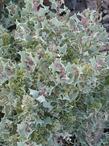Atriplex hymenelytra
Desert Holly.
Desert Holly is a 2-3 ft high, gray-white subshrub that grows from Utah to southern California. This Atriplex is sometimes used in decorations. Needs good drainage or desert conditions, and as little water as possible to keep alive. This plant will survive the sharp desert lows of -10 F., but will not survive extended temperatures of 20 F., though, particularly with wet winter soils. Basic rule on this one is if the ground freezes, the plant is dead. If your ground does not freeze this plant should do ok. This plant will tolerate a great deal of alkalinity. (Note: The Atriplex species from arid environments have a C4 photosynthetic pathway which is generally a more efficient way for the plant to conserve water. They will defoliate under extreme drought. The salt they accumulate in their leaves allows them to extract water from the soil other plants cannot. They need to be under some form of water stress, either drought, salt, or salt spray (Sharma). Grows with Xylorhiza tortifolia, Salazaria mexicana, Sphaeralcea ambigua, Encelia farinosa, Physalis crassifolia, Nicotiana obtusifolia, Peucephyllum schottii, and Cucurbita palmata, among boulders in creosote woodland. The Atriplex species tolerate and remove the excess salts by bladders in their leaves that act as salt sinks, keeping the salt from the plant cells. As the old leaves are shed or eaten the salt is removed from the plant. Atriplex confertifolia can handle 30 ppm Boron in solution. (Most plants burn out at 1-5 ppm. ) (Schirmer&Breckle)
Atriplex hymenelytra tolerates alkaline soil, salt and sand.
Foliage of Atriplex hymenelytra has color silver and is evergreen.
Flower of Atriplex hymenelytra has color yellow.
Communities for Atriplex hymenelytra:Creosote Bush Scrub.
| ph: | 6.00 to 7.00 |
|---|---|
| usda: | 8 to 10 |
| height[m]: | 0.50 to 0.60 |
| width[m]: | 0.20 to 1.00 |
| rainfall[cm]: | 13.00 to 26.00 |





